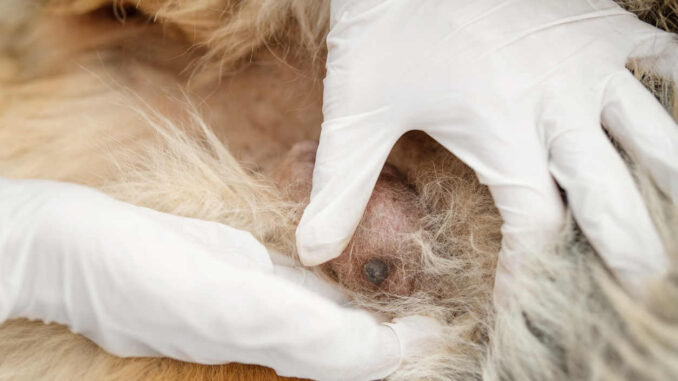
This article was updated on January 20th, 2024
Since dog mammary tumors make up more than 40% of all diagnosed tumors in dogs, it’s something that we deal with on a nearly weekly basis. If caught early, most small mammary tumors can be removed. However, if early detection doesn’t occur, treatment gets harder and other complications arise as well. One of those complications is mammary tumor rupture.
We’re here to walk you through what happens when a dog mammary tumor ruptures, what it looks like, and what you can do about it.
What Happens When a Dog Mammary Tumor Ruptures?
Dog mammary tumors may grow very quickly, and what was a small lump a few weeks ago quickly turns into a large mess. Those tumors can also become inflamed and swollen, further increasing their size. The skin over the tumor may burst open, causing bleeding, fluid leakage, and even some tissue to come out.
Ruptured mammary tumors in dogs are very painful and may cause a dog to stop eating and be extremely lethargic.
*** warning, graphic image ***
See this picture of a ruptured mammary tumor in a dog.
Does a Ruptured Mammary Tumor Impact Life Expectancy?
The actual process of rupturing doesn’t necessarily affect the life expectancy of a dog. However, rupturing of a mammary tumor is usually indicative of advanced mammary cancer, which definitely decreases a dog’s life expectancy. To learn more, read our article about Survival Rate & Life Expectancy for Dogs with Mammary Tumors.
What Does it Mean When a Dog Mammary Tumor Leaks?
Some dog mammary tumors can cause some discharge from the associated nipple. This is just another sign to help clue you in that your dog needs checked out. Some tumors may also leak or ooze fluids or blood from other areas. This usually means that the tumor is in advanced stages.
What Does a Bleeding Dog Mammary Tumor Look Like?
Whether or not you noticed a lump or bump before, a bleeding tumor is likely to draw your attention. You may notice spots of blood on your dog’s bed or wherever they lie down. The fur may be matted or you may just see what looks like an open wound on their belly, as shown on this picture (warning: graphic image).
At-Home Treatment and First-Aid
Any lumps or bumps should be seen by your veterinarian as soon as possible, especially if those lumps have ruptured. But in the meantime, you can try to keep your dog as comfortable as possible by:
- Giving them a quiet place to rest
- Apply a light bandage to help keep the area clean
- Your vet may advise you to give an anti-inflammatory to make them more comfortable
How to Make a Bandage
Depending on where your dog’s mammary tumor is and their size, you can use an old t-shirt or pair of shorts for larger dogs or a child’s shirt, baby onsie, or kid’s undies for smaller dogs.
Just find something that will cover the area snuggly. You can also slip a sanitary pad over it if it’s leaking a lot of fluid.
Another option is loosely wrapping an ACE bandage or vet wrap around your dog’s chest or belly. These bandages may slip more easily but will work for a short time.
Is Vet Treatment Needed?
There are no at-home treatments for dog mammary tumors. They will need to be seen by a veterinarian as soon as possible. With any luck, you’ll be able to catch mammary tumors while they are small and more easily treated. But if that isn’t the case, it’s not too late to see your vet, even if the tumor has ruptured.
How Will a Vet Treat a Rupture?
Diagnosis
Dogs with suspected mammary tumors will get a complete exam, including listening to the heart and lungs and palpation of the lump. A fine needle aspirate may be done using a needle to try to suck out some of the cells from the lump. These cells can then looked at under a microscope to determine the type of issue. Bloodwork, x-rays, and ultrasound may be used to see if the tumor has spread.
Treatment
Nearly every dog mammary tumor is going to be treated by surgical removal. Smaller tumors will require a smaller surgery, and larger tumors will require a larger area to be removed. Ruptured tumors will often be treated with removal as well. Chemotherapy or radiation may be advised following surgery for some types of tumors.
Intact females may be spayed at the time of surgery to help reduce recurrence.
Cost
The cost for removing a mammary tumor is going to vary greatly depending on the size and number of tumors. If your dog has a ruptured mammary tumor, it’s more likely a large one, so it will probably end up costing you more. Expect to pay at least $1,000-$3,000 for this surgery.
What you Should Know Before the Vet Visit
Try to give your vet the most accurate history of the mammary tumor that you can. Let them know when you first noticed it, if it’s grown since then, and if they are showing any other signs. If the first thing you noticed was the bleeding rupture, be sure to let them know that as well.
Recovery Expectations After a Dog Mammary Tumor Rupture
Most dogs will recover well from a mammary tumor removal. Expect a large incision to keep an eye on for redness, swelling and discharge. Most incisions will heal within a couple of weeks. Dogs will need to be kept from licking or chewing at the incision, as well as out of water, until it is healed. An e-collar or soft wrap may be needed. Restricting her activity level to keep her from running and jumping is also necessary to prevent her from ripping out her stitches.
These tumors can reoccur, so it’s important to keep a close eye on your dog’s belly to catch any new lumps while they’re still small.
If your dog was diagnosed with an inflammatory carcinoma, surgery usually isn’t as beneficial. Instead, your vet may have advised radiation, chemotherapy, or palliative care.
Prognosis
A ruptured mammary tumor is usually a sign of advanced cancer in your dog. While the treatment options of surgical removal and chemotherapy are usually the same, the prognosis isn’t as good as it would be for a smaller lump. That just because the longer a tumor is allowed to grow, the more chance it has to spread to other areas. Learn more about Survival Rate & Life Expectancy for Dogs with Mammary Tumors.
What Are Mammary Tumors?
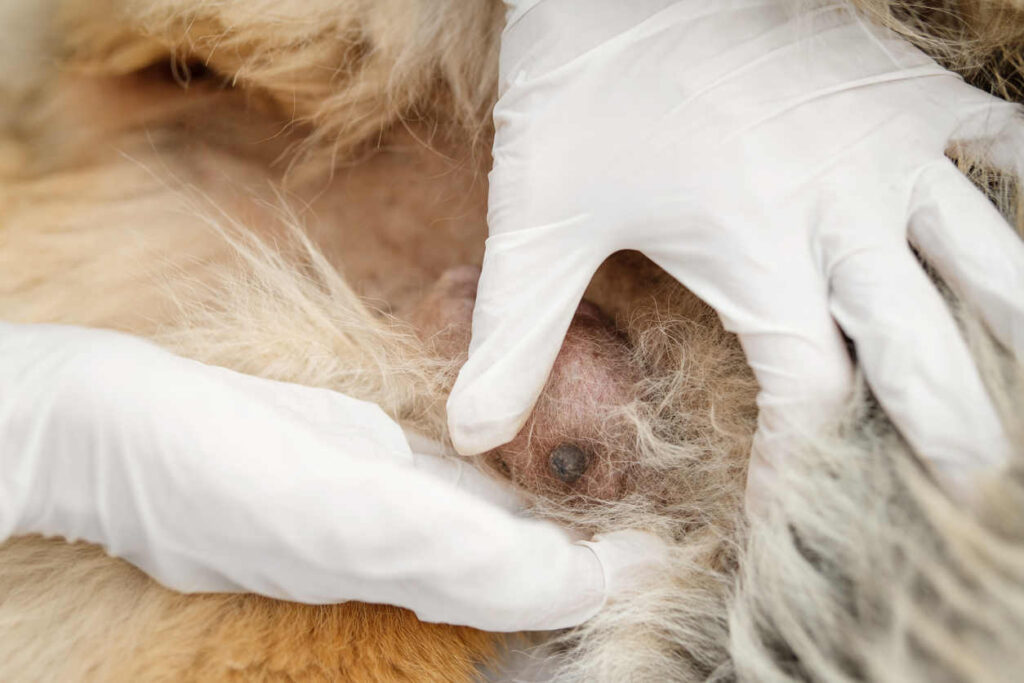
A female dog has five sets of mammary glands and their collective tissues that go from the armpits to the groin area. When dogs are spayed before their first heat, this mammary tissue stays undeveloped and at a much lower risk of developing mammary cancer. When female dogs remain intact or are spayed sometime after that first heat, that mammary tissue is fully developed, exposed to reproductive hormones, and at much more of a risk for developing mammary tumors down the road.
Mammary tumors come in many forms, some that are cancerous, or malignant, and some that are benign, or non-cancerous. Tumors are malignant about 50% of the time and benign about 50% of the time. Dogs can even have both forms at the same time.
Mammary tumors can be small, firm, well-defined, and moveable, or large, soft, irregular, and fixed to the underlying tissues. There may be one lump associated with one gland, or multiple lumps spread throughout the mammary chain.
If caught early on, most tumors will be small and not have spread to other glands or areas of the body. However, not every mammary tumor is caught early and can instead grow larger, become inflamed, bleed, leak, and even rupture.
Dogs with mammary tumors in the early stages most likely won’t show any other signs. However, dogs with advanced mammary cancer may have a decreased appetite, weight loss, and pain.
There is a very aggressive, yet rare, form of dog mammary tumors called inflammatory carcinomas. These types of tumors are very prone to skin ulcerations, bleeding, and leakage. Inflammatory carcinomas spread quickly to other areas of the body, including bone, and are often unresponsive to regular treatments.
Related posts:
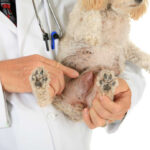 Life Expectancy & Survival Rate for Dogs with Mammary Tumors - Key insights: For benign tumors or malignant ones that haven’t yet spread, removal (without reoccurrence) is often curative. Benign tumors… [...]
Life Expectancy & Survival Rate for Dogs with Mammary Tumors - Key insights: For benign tumors or malignant ones that haven’t yet spread, removal (without reoccurrence) is often curative. Benign tumors… [...]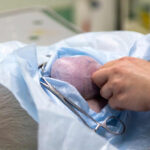 Cost of Removing Dog Mammary Tumors [By Surgery Type and Location] - ✔️Article written by a veterinarian, and reviewed by Dr. Whittenburg, Pet Hospital Director. Mammary tumors in female dogs are extremely common. So… [...]
Cost of Removing Dog Mammary Tumors [By Surgery Type and Location] - ✔️Article written by a veterinarian, and reviewed by Dr. Whittenburg, Pet Hospital Director. Mammary tumors in female dogs are extremely common. So… [...]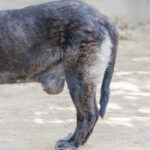 Dr. Bonk Explains Mammary Tumors in Dogs (With Pictures) - Not only are dogs capable of developing breast or mammary cancer, but they also do so at an alarming rate,… [...]
Dr. Bonk Explains Mammary Tumors in Dogs (With Pictures) - Not only are dogs capable of developing breast or mammary cancer, but they also do so at an alarming rate,… [...]Disclaimer: This website's content is not a substitute for veterinary care. Always consult with your veterinarian for healthcare decisions. Read More.



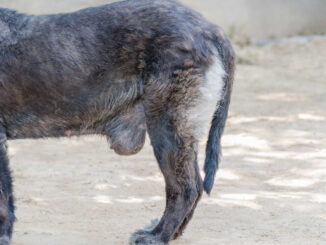
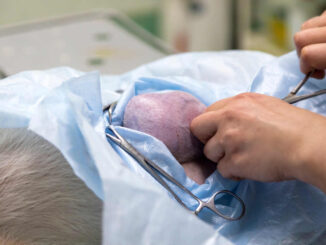
I got more information from this page than from my Vet. My Babypuppy is 12 yrs. old and maybe 3 lbs. When I first noticed it was a very small “knot”. In no time, size of a baseball. Her vet felt around her belly and said oh, well she has 3-4 more. I asked more what, she said cancer. I couldn’t stop crying!! 2 mths. later to anemic for surgery. She has been chewing on it. vet said 2 wks – 1 month. they gave up on her 2 sec. in. Thank you for this page and all the information. and yes she is my world!!!